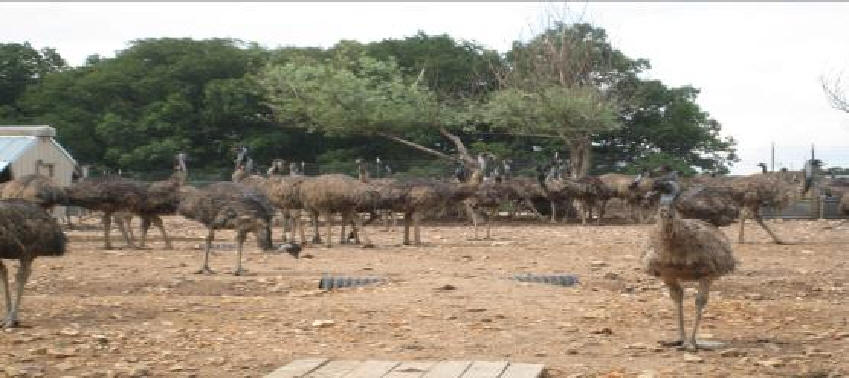|
NATCHURAIL healing OIL |
|
|
|
|
They have small wings
and a long neck and legs. They have the ability to run at high
speeds (30 mph). Their feet have only three toes . They have a soft
bill, adapted for grazing. The neck of the Emu is pale blue. They
have brown to grey-brown plumage the shafts and the tips of the
feathers are black.
Solar radiation is absorbed by the tips, and the inner plumage
insulates the skin. Allowing the bird to be active during the
heat of the day.
On very hot days, Emus pant to maintain their body temperature,
their lungs work as evaporative coolers. Their calls consist of loud
booming, drumming, and grunting sounds that can be heard up to
(1.2 mi) away. The booming sound is created in an inflatable neck
sac. Emus
predominately travel in pairs. Emus are also able to swim when
necessary. They eat a variety of plant species. They also eat
insects, including grasshoppers
and crickets, caterpillars, ants.
Emus also require pebbles and stones to assist in the
digestion of the plant material. They also eat charcoal, scientists
still do not know why.
Emus form breeding pairs during the December and January, and may
remain together for about five months. Mating occurs in the cooler
months of May and June. During the breeding season, males experience
hormonal changes, including an increase testosterone levels, and
their testicles double in size. Males lose their appetite and
construct a rough nest in a semi-sheltered hollow on the ground from
bark, grass, sticks, and leaves. The pair mates every day or two,
and every second or third day the female lays one of an average of
11 (and as many as 20) very large, thick-shelled, dark-green eggs.
The number of eggs varies with rainfall. The eggs are on average and
weigh between (1.5 and 2.0 lb), which is equivalent to 10–12 chicken
eggs in . The first verified occurrence of genetically identical
twins was in the Emu. The male after his mate starts laying, and
begins to incubate the
eggs before the laying period is complete. From this time on, he
does not eat, drink, or defecate, and stands only to turn the eggs,
which he does about 10 times a day. Over eight weeks of incubation,
he will lose a third of his weight and will survive only on stored
body-fat and on any morning dew that he can reach from the nest.
Incubation takes 56 days, and the male stops incubating the eggs
shortly before they hatch. Newly hatched chicks can leave the nest
within a few days. They stand about (5 in) tall, weigh (18 oz), and
have distinctive brown and cream stripes for camouflage. The male
stays with the growing chicks for up to 7 months, defending them and
teaching them how to find food.
Emus are farmed primarily for their meat, leather, and oil. Emu meat
is a low-fat meat (less than 1.5% fat), and with cholesterol at
85 mg/100 g, it is comparable to other lean meats. Most of the
usable portions are, like other poultry, dark meat.
Emu fat is rendered to produce oil for cosmetics, dietary
supplements, and therapeutic products. There is some evidence that
the oil has anti-inflammatory properties.
Emu leather is used in such small items as wallets and shoes,
often in combination with other leathers. The feathers and eggs are
used in decorative arts and crafts.
|
| The above statements have not been evaluated by the FDC. We make no claims expressed or implied. Keep out of reach of children. Keep out of eyes. If results occur that make conditions worst discontinue use. If problems persists contract your doctor. |
|
To contact us: JOHN BAIRD BIRMINGHAM AL 35214
HOURS: M—F 9:00AM—5:00PM
PHONE: (205)674-5626
EMAIL: NATCHURAIL@USA .COM |
|
Copyright 2010 NATCHURAIL.COM. All Rights Reserved. |




